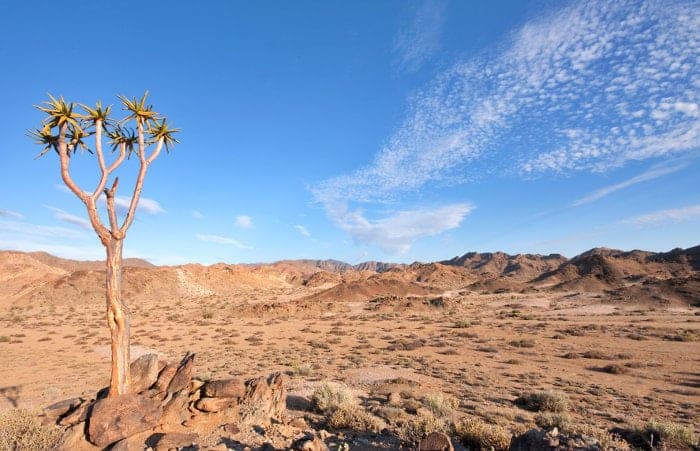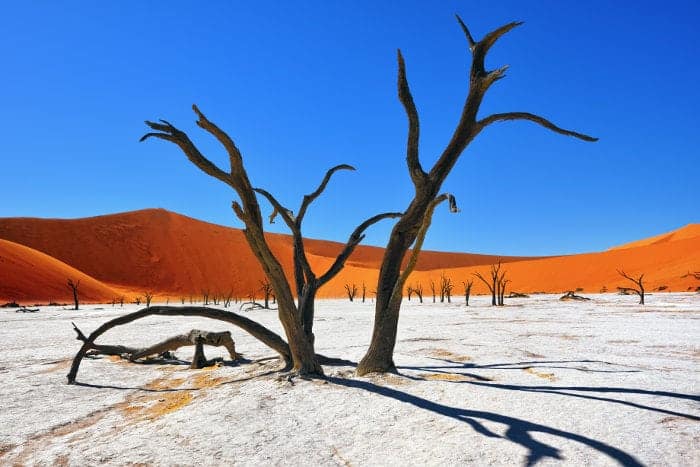!Ai-!Ais/Richtersveld Transfrontier Park

Great For: Self drive safari adventure.
Highlights: Relaxing and game viewing by the river.
Straddling the Namibia South Africa border, this large and vastly underrated park is wonderful if you are on a self drive safari. It’s filled with surreal trees and rock formations, along with dusty desert plains.
Wildlife doesn’t thrive here but it is supported by permanent water; you’ll find plenty of ungulates and elephants along the river or at one of the waterholes.
Don’t expect a spellbinding safari experience but a place of peace where animals roam an ethereal land.
Best Time to Visit !Ai-!Ais/Richtersveld Transfrontier Park: Dry season is better for game viewing, from June to September being best.
Also Consider: The sense of space in Botswana’s Central Kalahari.
Combine With: Etosha National Park is only a few hours further north.
Caprivi Strip

Great For: Making your own adventure; camping and self drive safari.
Highlights: Lots of elephants and beautiful landscapes.
Namibia’s lush panhandle is broken up into a string of smaller national parks, standing either side of a quiet highway that’s crossed by elephants. Animal life isn’t profuse but it’s really easy to get close to, with large elephants herds the ultimate attraction.
There are some excellent camps and the area is best explored with your own vehicle. Just hop between the national parks and create your own adventure. Bwabwata is the largest park, while Mudumu and Nkasa Rupara are other key considerations.
Best Time to Visit the Caprivi Strip: The dry and cooler winter months are best (May to August), although anytime outside mid-summer will be enjoyable.
Also Consider: Anywhere in Southern Africa!
Combine With: Victoria Falls and the Okavango Delta. Or visit the Caprivi Strip on route between Etosha National Park and Chobe National Park.
Damaraland

Great For: Phantasmagorical landscapes and solitude.
Highlights: San rock art; hiking and cycling trails; the sense of space.
Damaraland is quick to make you feel humbled by the power of nature. The landscape is huge, boulders towering high above you and valleys seeming to stretch for eternity.
It’s a wild and beautiful place that’s perfect for escaping the world; the solitude is remarkable and really memorable. Desert wanderers pass through so you’ll see the odd elephant or four-legged migrant, although not from up close.
Definitely do get close to the San rock art though, which is amongst the finest rock art on the planet. Don’t come for loads of animals; come for hiking and cycling trails, plus other adventures in a surreal land.
Best Time to Visit Damaraland: As with most of Namibia winter is cooler and makes the adventure more accessible.
Also Consider: The space of the Central Kalahari in Botswana.
Combine With: Etosha National Park is only a few hours further north.
Etosha National Park

Great For: A huge and highly evocative wilderness experience, combined with very easy game viewing (a rare combination).
Highlights: Rhinos, battles around the water, wildlife photography.
Namibia struggles to attract the same number of safari visitors that hit neighbouring South Africa or Botswana. But in Etosha National Park they have one of Africa’s ultimate destinations.
You’ll connect with your wild side here, no doubt about that. Rhinos wandering, elephants hooting, hyenas prowling, and all manner of strange scenes around the water.
Everything evolves around the Etosha Pan and lodges overlooking this ephemeral waterhole are extremely good value. Etosha is easy to explore but incredibly wild, and it’s wonderfully devoid of visitors.
Best Time to Visit Etosha National Park: Game viewing is easier in the dry season, starting from April and getting better all the way through to November. December to March are hot and humid (occasionally rainy) yet very beautiful in a different way.
Also Consider: The north of South Africa’s Greater Kruger or Botswana’s Central Kalahari Game Reserve.
Combine With: A longer experience in Namibia, including Damaraland, Sossusvlei, the Caprivi Strip, perhaps even onwards to Botswana and Victoria Falls.
Kaokoland

Great For: Cultural encounters; one of Africa’s wildest adventures.
Highlights: Meeting Himba people; wild camping; going off the beaten track.
The northwestern part of Namibia is almost impossibly wild. It feels like Africa from 500 years ago, complete with small Himba communities, non-existent roads, and wildlife that’s always on the move.
You need your own four-wheel drive vehicle and a massive sense of adventure, Kaokoland is the destination for an off-road-trip in lands that have hardly been charted.
It’s not a destination for first-time visitors to Africa. But if you know what you’re doing it’s a superb wilderness expedition.
Best Time to Visit Kaokoland: Shoulder season is best, April to June or September to November.
Also Consider: Parks like Ruaha in Southern Tanzania for really going off the beaten path.
Combine With: Most start in Etosha then head north to Kaokoland.
Namib-Naukluft National Park

Great For: The world’s most evocative sand dunes; desert adventure.
Highlights: The clay pans of Sossusvlei and Deadvlei.
The Namib-Naukluft is the stuff of legend, tens of thousands of square kilometres where there’s nothing but sand. Every angle is different, the sand shifting colour as the sun crosses the sky.
It’s enormous and mostly uncharted, a vast barrier of dunes stretching from the coast to Namibia’s interior. The only way to get a sense of it all is on a scenic flight.
However, the most iconic experience is found in the place where the desert becomes accessible. Deadvlei is the photogenic icon, ancient trees standing like sentinels on an old clay pan. Sossusvlei is just as picturesque and Namibia’s most famous desert destination.
Best Time to Visit Namib-Naukluft National Park: May to September is best for avoiding the relentless summer heat.
Also Consider: No other desert in the world is like the Namib.
Combine With: Namib-Naukluft is a classic stop on an overland journey through Namibia; Skeleton Coast is likely to be next on the itinerary.
Skeleton Coast National Park

Great For: Seals and wild four-wheel drive adventure.
Highlights: Accessibility of a ghostly land.
Adventure thrives where the desert meets the Atlantic Ocean, where Africa’s sand dunes flow into crashing waves. It’s a thrilling place to take your four-wheel drive vehicle off road and an easy place to connect with your wild side.
The national park is accessed via a rugged dirt road from Swakopmund, with huge colonies of Cape fur seals the first main attraction.
Keep driving north and you find the skeletal remains of old ships, a series of ghostly shipwrecks that are slowly being reclaimed by the desert. There’s also some of Africa’s best fishing to be found here.
Best Time to Visit Skeleton Coast National Park: In the winter, May to September.
Also Consider: Namib-Naukluft National Park.
Combine With: Swakopmund and a safari in the north of Namibia.